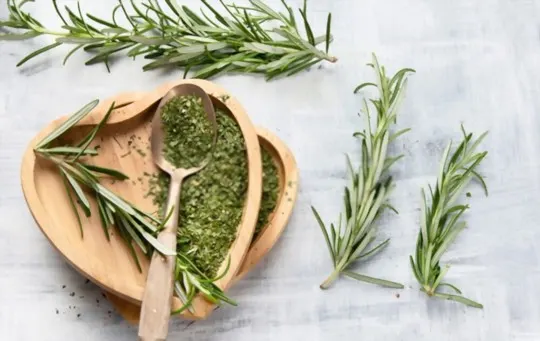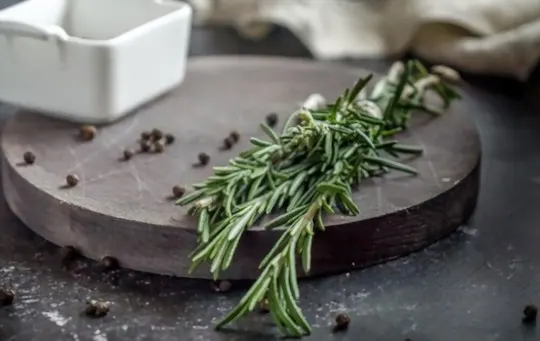Rosemary is one of the most used herbs in various recipes. This aromatic herb enhances the taste profile of a dish.
Besides using it as a cooking ingredient, it’s known to have medicinal properties which provide multiple health benefits.
In addition, it’s used for making perfumes and essential oils.
It’s a versatile herb, but what exactly does it taste like on its own? If you have the same question, this post will have it covered.
Keep reading as we answer to: what does rosemary taste like, its taste profile, and more.
What is Rosemary?

Rosemary, scientifically known as Salvia Rosmarinus, is a native of the Mediterranean region and belongs to the Lamiaceae family.
It’s a perennial herb that has needle-like leaves.
The fragrant evergreen herb bears small blue flowers.
The color may also vary from purple to pink and white.
During ancient times, the Romans used it for making perfumes or as bath soaks.
It is also used as a decorative plant, and its leaves, flowering apices, and twigs are extracted for different uses.
It grows up to a height of 4 feet and can sustain well in a hot temperate region.
Rosemary as a cooking ingredient is applicable in various types of recipes.
You may use it in stews, baking, salads, chicken dishes, and more.
Some people use dried rosemary, too, for seasonings.
The unique fragrance of this herb makes the dish aromatic and enjoyable, particularly for fish and meat-based dishes.
What Does Rosemary Taste Like?

So, the burning question is, what does rosemary taste like on its own? When it’s not mixed with other ingredients, it has a strong, minty, and woody flavor.
You may also get a hint of sweet flavor.
It shares a similar flavor with sage, lavender, and mint.
Aside from its slightly sweet taste, it also has a bitter note.
It may not be overpowering, but you may feel it when having it alone.
Fresh rosemary leaves have an intense flavor compared to dried ones.
If you prefer a mild flavor, dried rosemary would be great.
When it comes to nutritional value, both type is packed with nutrients.
So, the nutritional value remains the same whether you opt for dried or fresh rosemary.
It contains essential nutrients which help in improving your health condition.
For instance, it’s a good source of antioxidants that help in fighting against infection and tumor cells.
Additionally, it’s a rich source of calcium, manganese, Vitamins, and iron.
So, not only that it enriches the flavor in dishes, but it is good for your health too.
Rosemary is readily available in grocery stores, although you may not find fresh ones in some places.
If you can’t find the fresh ones, the dried ones are readily available in grocery stores.
Or another great option would be to grow them in your kitchen garden.
It’s easy to maintain and doesn’t require ample space.
Doing this will allow you to use this fragrant herb whenever needed, either for cooking or making homemade essential oils.
How to Cook and Serve Rosemary?

Rosemary is an incredible herb to use in a variety of dishes.
It’s mainly used as a seasoning in salads, casseroles, soups, and stews.
This ingredient is mainly used in Mediterranean, Moroccan, and Middle Eastern cuisines.
It blends well with pork chops, lamb, baked potatoes, and tomatoes.
You may also add this herb to cakes, bread, and pastries.
In short, the applicability of this evergreen shrub is endless.
All you need is to put your creative cooking skill to use appropriately.
If you’re new to this herb, here are some ideas you may apply:
- Rosemary skewers: If you’re making chicken skewers, add rosemary stems to give a delightful aroma. It changes the overall taste of the skewer. .
- Rosemary salt: Whether dried or fresh rosemary, mix it with salt and put it in an airtight container for two weeks. You may use this in multiple recipes, including grilling, bread topping, and roasted vegetables.
- Lemonade with fresh rosemary: Treat yourself this summer with fresh rosemary lemonade. All you need is lemon juice, salt, rosemary springs, and a glass of water. It’s refreshing and healthy and makes an excellent accompaniment to any dish. You may also add ice cubes if you want to chill.
It’s advisable to have this herb in small quantities as excess consumption of this may lead to spasms, vomiting, and coma.
Conclusion
Adding rosemary to dishes enhances the flavor and gives a pleasing aroma.
Besides, it provides multiple health benefits but advisable to have it in moderation.
It’s a versatile seasoning herb that blends with any ingredients.
The smell of this herb may be overpowering to some people but doesn’t affect the taste profile of a dish.
In fact, it enhances the overall dish.
Use this herb in your next dish and taste it yourself to determine whether it’s to your liking.

What Does Rosemary Taste Like? Does it Taste Good?
Ingredients
- Rosemary
- Ingredients from your favorite recipes
Instructions
- Depending on the ingredients used, the cooking method, and the type of dish, the taste of the food can vary greatly.
- Make sure to select a recipe that will elevate the food’s original flavor, and enjoy experimenting with different recipes!

Andrew Gray is a seasoned food writer and blogger with a wealth of experience in the restaurant and catering industries. With a passion for all things delicious, Andrew has honed his culinary expertise through his work as a personal chef and caterer.
His love for food led him to venture into food writing, where he has contributed to various online publications, sharing his knowledge and insights on the culinary world. As the proud owner of AmericasRestaurant.com, Andrew covers a wide range of topics, including recipes, restaurant reviews, product recommendations, and culinary tips.
Through his website, he aims to inspire and educate fellow food enthusiasts, offering a comprehensive resource for all things food-related.

Leave a comment